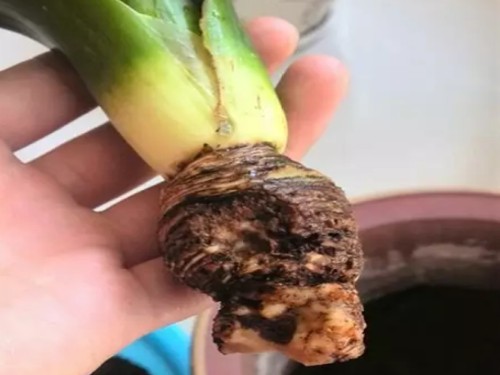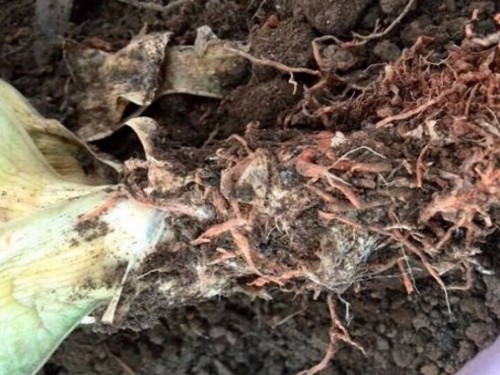Management after the rotting Root of Magnolia
The rotten roots of Cymbidium are mainly caused by excessive watering, high temperature, over-concentrated fertilization or raw fertilizer, and some may be caused by infection caused by bacteria in the cultivation medium. Whether the gentleman orchid can still live after its rotten roots mainly depends on whether the root axis is better, whether there is any separation between the leaf and the root axis, as well as the injury of the new leaves in the middle.
When the hot summer comes, the gentleman orchid is easy to rot if he doesn't pay attention to controlling the water. It's a great pity to let it go. Don't be discouraged. After treatment, you will come back from the dead. Below, I will introduce the rotting root treatment process that I have experienced personally.

Tools / raw materials:
Gentleman orchid (rotten root), coarse river sand or water moss, potassium permanganate, plant ash (ash of paper, grass, wood burning)
Methods / steps:
1. Root rot symptoms, the bottom leaves are dry and yellow, other leaves are yellow and lack of vitality. The following picture shows the root rot symptoms.
2. Take out the rotten root of the gentleman orchid from the basin, remove the rotten root, clean it thoroughly to prevent it from continuing to rot, and have a small bud. Postscript: this little tooth has also survived and grown up.
3. Soak the rotten roots with 1/1000 potassium permanganate solution for 30 minutes and disinfect the rotten roots, which makes the orchid more and more lifeless.
4. After disinfection, control water and use plant ash to smear the affected area (rotten root).
5. Control the water and dry for 1 day. Do not direct sunlight on the leaves. It is best to cover the leaves with a newspaper.
6. After drying, I planted the orchid in the coarse river sand or water moss. I planted it in the water moss. After 15-50 days, I can grow a new root of white fat.
The management after the rotten root of the gentleman orchid:
1. Rotten root treatment
Remove the rotten roots: plant the rotten orchids from the flowerpot, gently peel off the soil, then rinse the roots with water and clean the rotting roots with scissors. If any leaves are yellow or weak, it is best to cut off the damaged leaves as well.
Disinfection: soak the cleaned roots in 0.1% potassium permanganate solution for 5 minutes, then apply a little sulfur powder or plant ash or carbendazim, and then dry in a cool place (about 2 days).
2. Treatment of basin soil
The nutritious soil bought on the market has poor air permeability, and the soil is too raw or overripe. If the soil contains immature ingredients, long-term watering and fertilization in the basin soil will produce heat and easily rot the roots. Or the self-prepared flower soil is sticky, the water content is large and not easy to evaporate, and the air permeability is poor, and the bacteria will invade the plant with the wound, resulting in rotting roots. Therefore, the choice of flower soil before planting is very important.
If the flowerpot for breeding gentleman orchid is poor in air permeability, you can consider replacing it with a porcelain pot or a rough pottery pot.
3. Put it on the pot after the rotten root treatment.
After disinfection of the root re-planting, you can add river sand to urge the root. Properly raise the temperature of the plant and control it at 22-30 ℃. After two months, it can grow new roots and re-transplant to the nutritious potted soil. After planting, you should control watering, do not dry, do not water, so as not to rot the roots again, just put it in a cool and ventilated place.
4. Adjustment of water and fertilizer
The gentleman orchid should not be watered too much, but in the right amount. Too much watering will make the nutrient soil has too much water content, poor air permeability, root growth can not get enough oxygen, resulting in rotting roots. When watering, you should also be careful not to pour water into the center of the orchid, so as to avoid stagnant water along the stem to the root. Watering is usually done every two weeks, accompanied by fertilization.
Note:
1. Thoroughly disinfect
This thorough disinfection refers not only to the disinfection of the root of the magnolia, but also to the disinfection of the soil that has been re-boiled to prevent the root system from rotting.
2. Control of temperature and moisture
After the rotten root of the gentleman orchid is treated, the environment on the basin, the temperature had better be kept at 20-25 degrees Celsius, the ventilation effect must be good. In addition, less watering, basin soil is too wet, not only not conducive to rooting, but also the risk of decay again.
Also note that the flowerpot after the rotten root treatment had better be placed in the place of astigmatism to avoid direct sunlight, because the gentleman orchid at this time is very fragile, you think, ah, the roots have been cut off, of course you have to be gentle!
3. Control your hand
Some flower friends think that the root of the magnolia is rotten, although it has been treated and planted in the pot, but from time to time to check whether the root system still has a tendency to rot. In fact, this practice not only does not make any sense, but increases the probability that the orchid is infected with bacteria.
Time: 2019-06-01 Click:
- Prev

What about the rotten roots of Guanyin in potted plants?
Dishui Guanyin is a trade name, also known as Dishui lotus and bergamot lotus. Other common names include trace taro, wolf poison (Guangdong), wild taro, mountain taro, big root taro, big worm taro, celestial taro, Tianmeng, and so on. Taiwan's calla lotus refers to sea taro, so what about the rotten roots of dripping water Guanyin? Dishui Guanyin is perishable in summer.
- Next

What about the rotten root of tiger skin orchid?
Tiger Pilan is known as a natural street sweeper. It can effectively remove harmful substances from the air. In particular, it has a strong ability to absorb formaldehyde and can effectively remove harmful substances such as sulfur dioxide, chlorine, ether, ethylene, carbon monoxide, nitrogen peroxide and so on.
Related
- Fuxing push coffee new agricultural production and marketing class: lack of small-scale processing plants
- Jujube rice field leisure farm deep ploughing Yilan for five years to create a space for organic food and play
- Nongyu Farm-A trial of organic papaya for brave women with advanced technology
- Four points for attention in the prevention and control of diseases and insect pests of edible fungi
- How to add nutrient solution to Edible Fungi
- Is there any good way to control edible fungus mites?
- Open Inoculation Technology of Edible Fungi
- Is there any clever way to use fertilizer for edible fungus in winter?
- What agents are used to kill the pathogens of edible fungi in the mushroom shed?
- Rapid drying of Edible Fungi

